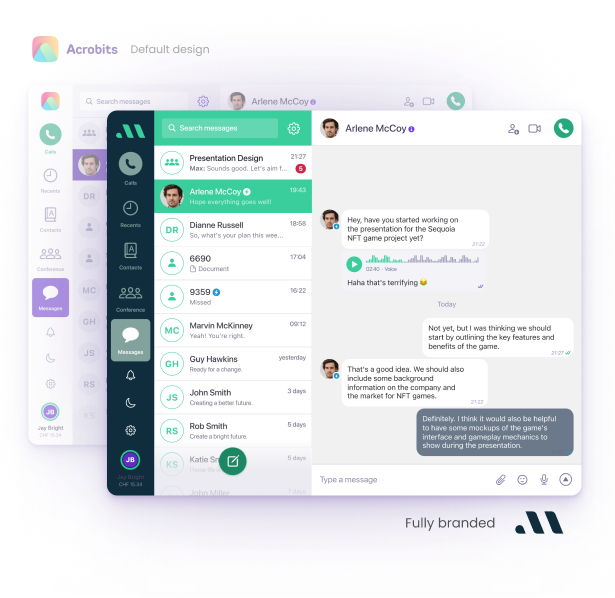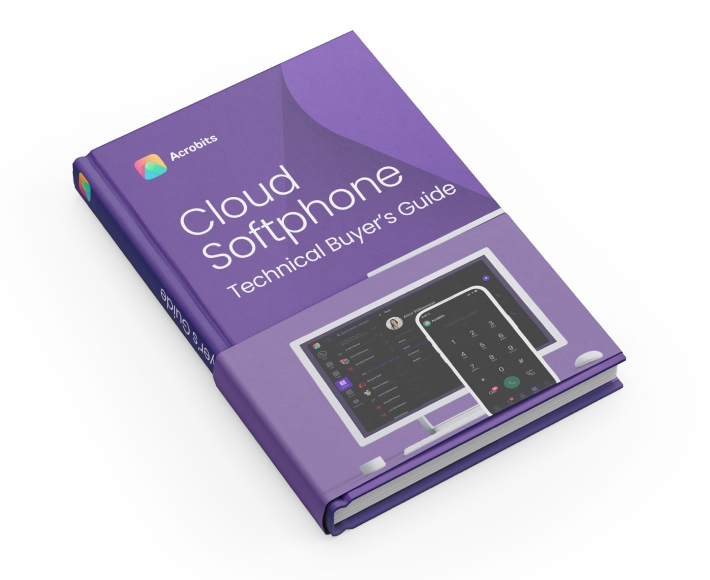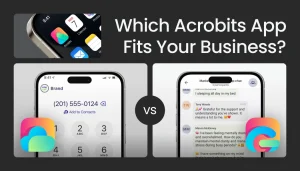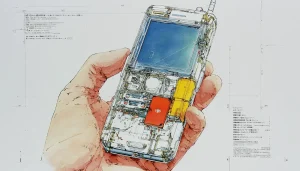
Build a white label softphone app
Create a custom white-label softphone with Cloud Softphone.
- No devs needed
- Native desktop apps
- 100+ premium features

Every telecom provider knows the appeal of a quick fix. Deploy a generic softphone app, get your users online, and move on.
But as the market surges toward $400 billion by 2034, the cracks in this approach are becoming impossible to ignore. Scaling, branding, and innovation all hit a ceiling fast.
Turnkey softphone solutions promise fast time-to-market and low upfront investment. For startups and MSPs, that sounds like a win.
But the tradeoff is rarely discussed: generic VoIP apps create a dependency that can quietly erode your margins and flexibility over time.
Consider the operational math:
The cost of using generic VoIP apps in telecom isn’t just about licensing fees. It’s about the opportunity cost of not being able to move as fast, or as far, as your market demands.
Out-of-the-box softphones often feature the vendor’s branding front and center.
Customers download an app, see a name that isn’t yours, and form an association that skips your brand entirely. For UCaaS and hosted PBX vendors, this is more than a cosmetic issue, it’s a strategic blind spot.
Brand equity is built on every touchpoint. If your users see another company’s icon, splash screen, or support link, you’re investing in someone else’s reputation. In a crowded market, that’s a recipe for churn and commoditization.
White-label vs generic softphone comparison studies consistently show higher customer retention and NPS when the provider owns the experience. Branded alternatives to generic VoIP apps turn every login into a brand interaction, not just a utility.
Standard softphone app customization options are usually limited to colors, maybe a logo, and a few toggles.
But what happens when your enterprise client needs a custom workflow, or your MSP business wants to embed analytics?
Generic softphone app limitations become painfully clear as soon as you want to differentiate:
Feature gaps in standard VoIP applications are not just minor annoyances. They become blockers to landing bigger deals, supporting complex customers, or innovating in response to new regulations.

Integration challenges with turnkey softphone systems are a recurring pain point for IT leaders. CRMs, billing platforms, custom analytics, and even basic provisioning often require manual workarounds or custom middleware.
This lack of interoperability slows down onboarding, increases support tickets, and introduces security risks. Vendor-dependent softphone platforms rarely offer full access to APIs or event streams, making automation and monitoring a constant headache.
For enterprises and managed service providers, fast integration is non-negotiable. Out-of-the-box VoIP client solutions may promise “plug and play,” but they rarely deliver on deep, reliable connectivity with your SIP core business systems.
Related read:
Security risks in off-the-shelf VoIP software are often invisible until something goes wrong.
Providers using generic softphone apps have little insight into how data is handled, where it’s stored, or how quickly vulnerabilities are patched.
For compliance-conscious operators, this lack of transparency can be a dealbreaker. Regulatory requirements like GDPR or HIPAA demand not just encryption, but audit trails and control over data flows. Vendor-managed updates and closed platforms limit your ability to prove compliance or respond quickly to incidents.
Cloud-based softphone alternatives to standard apps offer more options for encryption, data residency, and security policy enforcement. But only if you control the stack.
Customizable softphone solutions for UCaaS providers are more than a branding exercise. They’re a foundation for growth. When you control the user interface, feature set, and update cadence, you can:
It’s about future-proofing your business in a market where user experience, control, and integration are the battlegrounds for long-term survival.
The VoIP and UCaaS markets are growing at 11-18% annually. Providers relying on generic apps risk being left behind as competitors move faster, integrate deeper, and differentiate more effectively.
Owning your communication stack, through customizable, branded softphones, means you’re not just keeping up. You’re setting the pace.
The next decade will reward those who treat user experience and technical agility as core assets, not afterthoughts.
Curious about history? Check out our blog on the history of softphones.
Generic softphone apps may get you started. But as customer expectations rise and the market expands, the real winners will be those who invest in ownership, flexibility, and brand.
The cost of sticking with off-the-shelf VoIP communication software is measured not just in dollars, but in lost opportunity, loyalty, and growth.
Ready to see what’s possible when you own the experience? Explore how customizable, branded softphones can help you scale, differentiate, and lead in the years ahead
string(9) "book-demo" string(33) "Build a white label softphone app"
Create a custom white-label softphone with Cloud Softphone.

Picture this: your softphone app aces every backend test, but users drop off after the first call. Why? Technical reliability alone won’t win the adoption game, intuitive onboarding, seamless UI, and robust call quality all matter equally. Testing and launching a softphone app is a two-front battle, and neglecting either side puts your brand and […]

Not every VoIP user needs the same thing. Some just want a rock-solid app to connect their SIP line. Others need to launch a white-label softphone under their own brand. Acrobits offers two very different tools to cover both ends of that spectrum: Groundwire and Cloud Softphone. Feature Groundwire Cloud Softphone Pricing $9.99 one-time purchase […]

For many small and medium-sized businesses, the traditional PBX (Private Branch Exchange) phone system has long been the backbone of daily communication. As remote work becomes the norm and digital transformation accelerates, these hardware-bound systems are increasingly feeling like a bottleneck: they are costly to maintain, inflexible, and ill-suited for modern workflows. If you’re an […]

Business communication did not jump from desk phones to cloud apps overnight. It moved step by step as engineers pushed voice from dedicated copper into shared data networks, then from hardware into software. That path explains why softphones make sense now, and why so many teams are replacing desk hardware with apps. Rising maintenance bills, […]